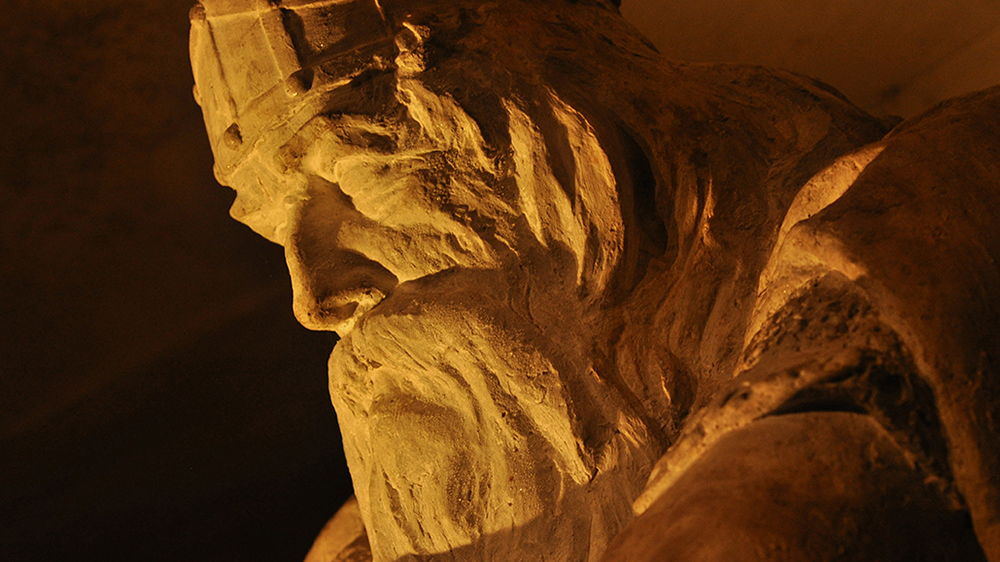Trond Kruke Salberg, professor of French literature at the University of Oslo, stumbled across the Danish mythological hero Ogier (Holger) while working on his doctoral thesis, just looking to examine a question regarding history of literature. The result was several decades of work.
A crucial, old text was found in one single ancient paper manuscript, where large parts were almost unreadable. Such a thing can make a professor of literature curious.
“After a while, I came up with the bright idea that I should publish the manuscript. It was a particularly special project,” Salberg explains.
“Heroic poems” in a hole-ridden document
In Denmark, Ogier the Dane is a national hero, even though he never existed in reality. Yet the first time he appears is in Old French texts. In “La Chevalerie Ogier” from the 12th century, he is the main character. This is one of the so-called “chansons de geste”, known in Norwegian as “heltekvad”: epic poems from the Middle Ages.
The original manuscript was located at the national library of France, in Paris. From Norway, Salberg ordered a film reel containing photographs of the manuscript. The letters were probably written with ink meant for parchment, and the ink had chemically reacted with the paper. This resulted in many large holes, as well as some black writing on a dark brown background.
Therefore, Salberg had to sojourn in Paris for many summers in order to decipher the original versions.
“When making analogue copies, each subsequent copy is of poorer quality. I could read a great deal more in Paris than I could through the film reel.”
The roots of history
It was an extremely fiddly job. Knowledge of the Old French in which the texts were written came gradually – the words could be very different to today's French. Strange abbreviations, missing punctuation and last but not least, the holes in the paper, were all very challenging. He could sit for several hours working on just a few lines of verse.
But he was not lacking in motivation:
“Historical studies are largely a study of old documents. If you can't read them accurately, you can't understand them properly. So without publishing old texts, we won’t have any history.”

A handsome hero
French heroic poems often speak of battles between the Franks and heathens, but they also speak of loyalty and relationships within Frankish society, such as treason towards Charlemagne – here a fictional figure.
Ogier the Dane, also a fictional figure, was involved in a little bit of everything. And it is this story that Salberg has now, after many years of work, made available in a text containing 30,502 lines of verse. The text encompasses both “La Chevalerie Ogier” and a long sequel, which was also written in the Middle Ages.
The Danish-born hero was extremely handsome. He had golden, curly hair, and a beautifully formed foot. He was also broad-shouldered. Texts from the Middle Ages often place great emphasis on men’s beauty, according to Salberg.
War with Charlemagne
But here, beauty and harmony end. The son of Charlemagne takes the life of Ogier the Dane’s son after losing a chess game. This results in a long war between Ogier and Charlemagne, in which Ogier receives help from various parties – among others, the Lombards in Northern Italy.
“Ogier the Dane was not just handsome. He was also very clever. For example, when at one point he is alone in a castle during the war, he makes wooden men and places them around the castle so that it looks like he has people there,” Salberg says.
In the end, however, he must escape from the castle and is taken prisoner. For many years, he sits in captivity, until Charlemagne finds that he needs his help.
La Chevalerie Ogier has a happy ending: Ogier is granted large realms by Charlemagne and gets married to the daughter of the King of England.
The hero did not age
But the story of Ogier the Dane does not end here. He continued to appear in the chivalric romances of the 14th century.
Here, Ogier ends up in the city of Acre in Israel/Palestine, following the battle against Charlemagne. This was the last place where the Christian crusaders held power in Israel after they had lost Jerusalem. In Acre, Ogier is betrayed by the notorious Templars.
Later, he travels to the Fairy Realm. There, he falls in love with Morgane, sister of the fictional King Arthur. Ogier lives in the Fairy Realm for 300 years without aging a day, before returning to France in order to aid a French king.
Strong, stubborn and alone
Stories were told about Ogier the Dane for several hundred years, both in Southern and Northern Europe.
“Why did Ogier the Dane receive the heroic status he did?”
“First and foremost, he was extremely big and strong. In addition, you have all the fantastical elements. When both Ogier the Dane and King Arthur were mentioned in the same text, the medieval people could have their cake and eat it too.”
But Ogier is not solely a positive hero, Salberg adds. He's both stubborn and independent. In some instances, he is also a lonely hero, who is betrayed by everyone or loses all his comrades in battle.
“How popular was he?”
“We don't know. There have most likely been many lost manuscripts and many lost versions that once existed. Chansons de geste and the early chivalric romances were forms of high literature, but after a while, more popular forms were written. We're probably talking about the same fascination that we have for modern soap operas.”
The Danish-Norwegian version was widely read in the 19th century
Towards the end of the Middle Ages, in the 15th century, the first prose versions appeared, not in verse form. The Dane Christiern Pedersen came to Paris in the 16th century and learned about the story of this Danish hero who he had never heard of. He thought much like Salberg: I have to do something with this.
“Pedersen could not understand Old French, but he made sure that the French prose version was translated into Latin, which he then translated into Danish himself. This is the background for the Danish-Norwegian Ogier the Dane tradition,” Salberg explains.
Pedersen called the work “Olger Danskes krønike” (“The Chronicle of Ogier the Dane”), a book that was republished a number of times up until the 19th century and was read by many people in Denmark-Norway.
“In Norway, we actually feel quite proud if a Norwegian becomes popular abroad …?”
“Yes, and Christiern Pedersen felt the same way. Here, there was a Dane who people were noticing. I think Pedersen embellished his chronicle here and there, since it places more emphasis on Denmark than the French versions do.”
In the Middle Ages, Ogier the Dane had also passed through the Nordic countries. Under the name Oddgeir, he can be found as a hero in the Karlamagnus-saga, a Norwegian-Icelandic saga about the fictional Charlemagne. The writer gathered his material from the French heroic poems and made the name sound more Nordic.
Significant inspiration for Tolkien
According to Salberg, the more recent “sword and sorcery” literature by J. R. Tolkien, for example, would not have been possible without the old chivalric romances and chansons de geste. They are based on many of the same elements. Tolkien himself was a Middle Ages philologist.
All these stories are characterised by people occasionally having wished to, and still wish to, escape from reality, Salberg thinks. In literature, you arrive in a world where you are liberated from economic worries. There is war, love, fighting and duels – even though Ogier the Dane came to Acre penniless and had to pawn his shield in exchange for shelter.
“Maybe there's some kind of comfort in presenting someone who can solve everyone’s problems? The fact that someone exists who is so strong that the moment they arrive, you know everything will be okay? That’s how it was with Ogier,” says Salberg.
In Denmark, Ogier became a national hero who stepped forward to save Denmark in times of need.
“Ogier the Dane had not only been to France, Italy and Israel/Palestine. He had been to the Fairy Realm, too. He possessed strength, courage and all the traditional heroic characteristics.”
